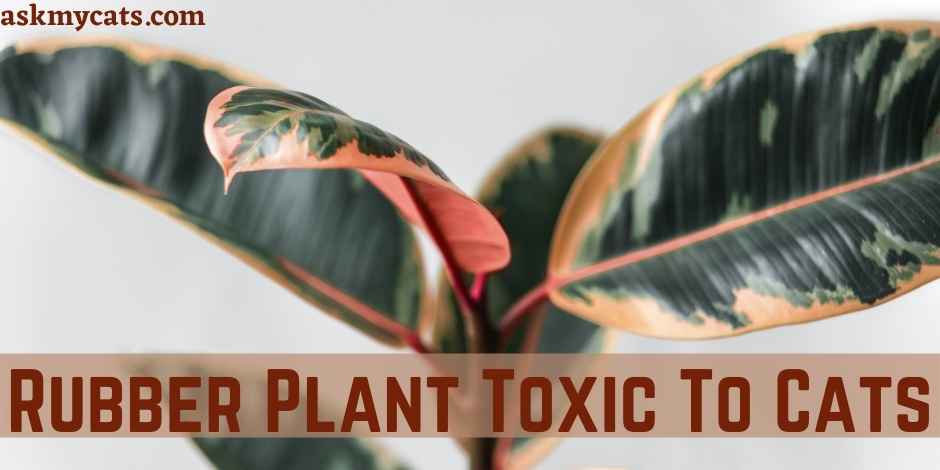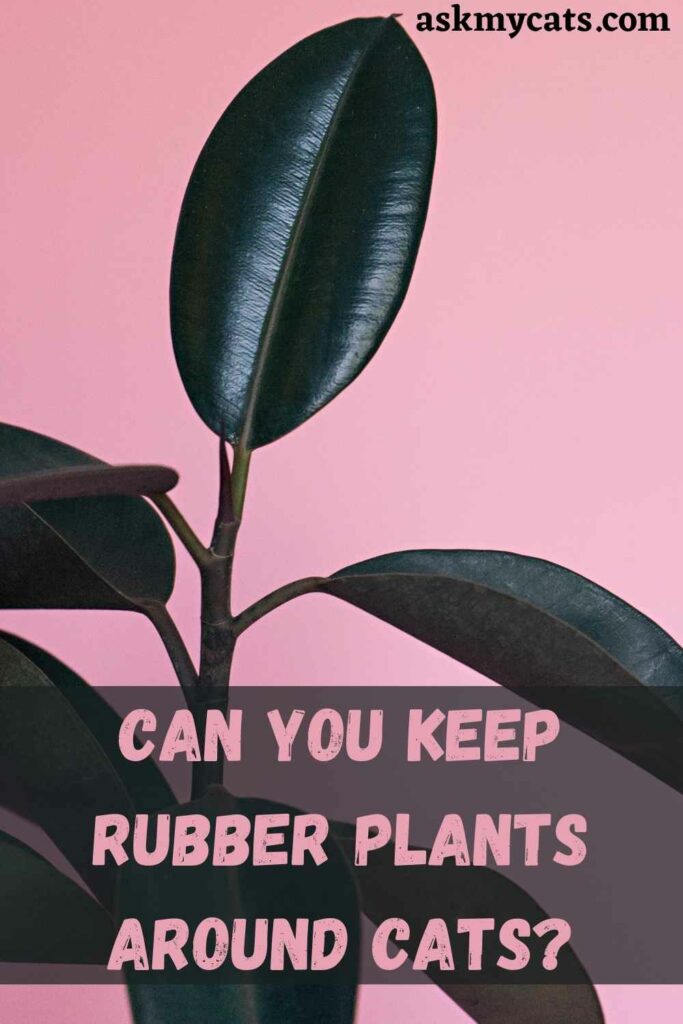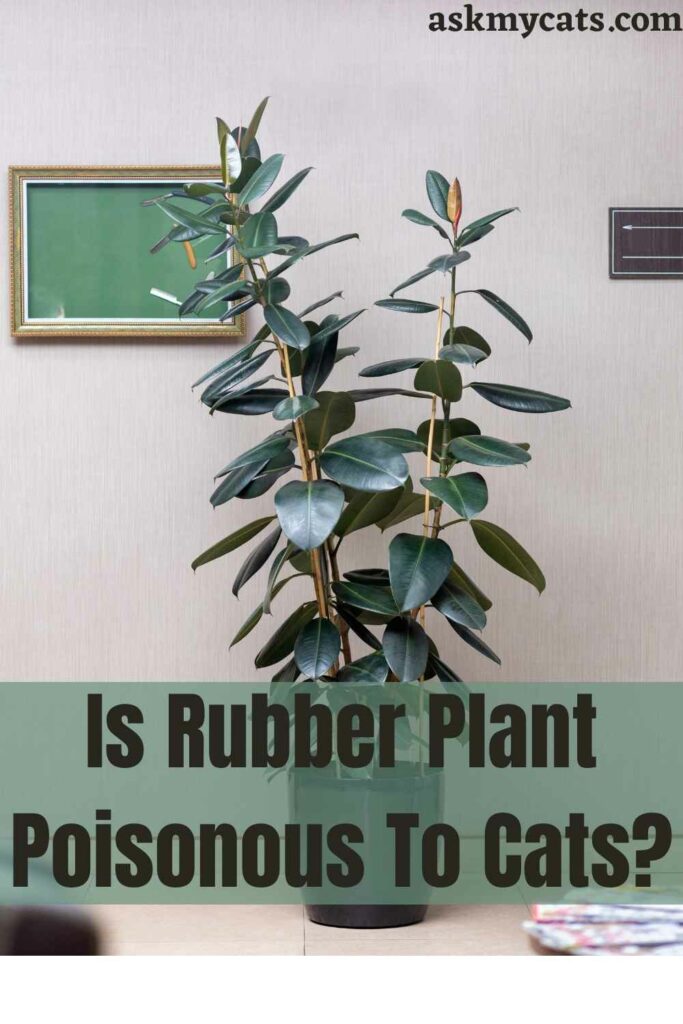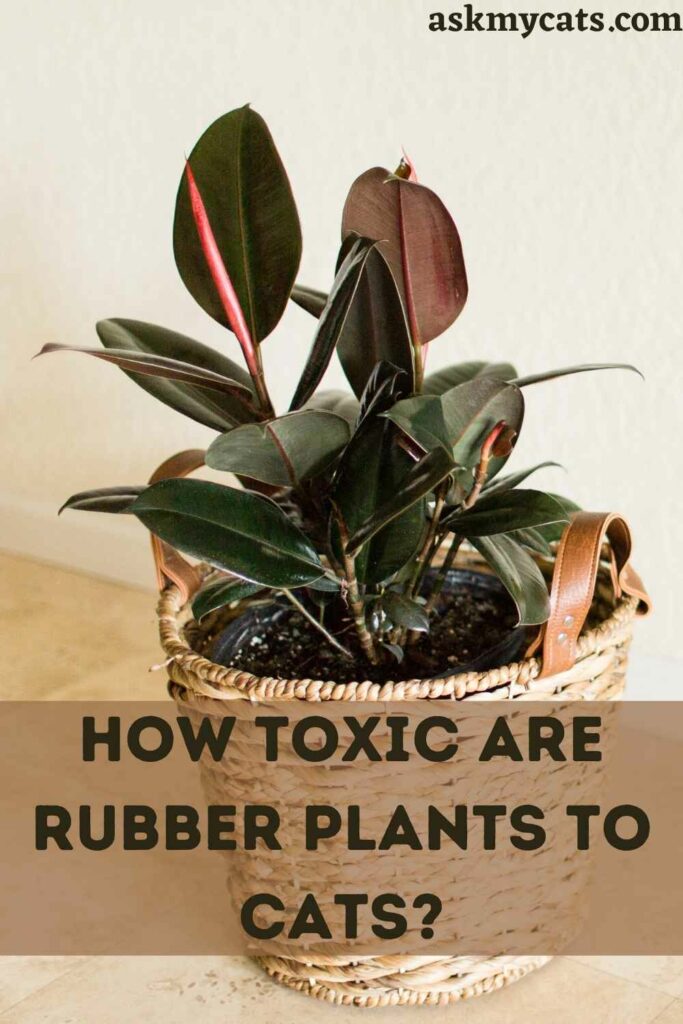If you like indoor trees, Ficus elastica is a must-have plant that you’ve probably heard of. Its name, often known as the rubber plant, comes from the latex-like sap it produces when wounded. Because of its gorgeous glossy foliage and ease of maintenance, this tropical is a favorite among houseplant enthusiasts.
However, is rubber plant toxic to cats?
Yes, rubber plant is toxic to cats. Cats are poisoned by latex, a milky sap secreted by a damaged rubber plant (Ficus elastica). If your cat eats any rubber plant material, it may endure drooling, vomiting, diarrhea, and a loss of appetite.
In this article, we will talk in detail, that how rubber plants affect cats, and why you should keep them both away from each other.


Give Your Cat the Perfect Day
Get the Free Ebook!
What Is Rubber Plant?
Rubber plant is a flowering plant from the Moraceae family that is native to eastern South Asia and Southeast Asia. It has naturalized in Sri Lanka, the West Indies, and the state of Florida in the United States.
Asia, India, and Malaysia are home to the rubber plant. Having said that, this species may now be found all over the world, including the United States. Rubber trees can reach heights of 80 to 100 feet (24-30 meters) in the wild.
Indoors, they stay considerably smaller, yet they still grow large enough to provide that gorgeous indoor tree look!
Bright but indirect light, ideally from south-facing windows, is ideal for rubber plants (in the Northern Hemisphere). Some varieties, such as the reddish ‘Burgundy’ and ‘Ruby,’ can withstand a few hours of direct sunshine per day.
Rubber plants, like other houseplants, have a strong inclination to bend in the direction of the sun. As a result, rotating the pots or moving them around from time to time is beneficial.
Once a month or so should suffice. However, when it comes to rubber tree care, this isn’t such a big concern. Unless your plant is on the verge of collapsing, it’s largely for cosmetic reasons.
Can You Keep Rubber Plants Around Cats?
No, you should not keep rubber plants around cats, if you want to do so, make sure they are out of reach of the cat.

Cats are poisoned by latex, a milky sap secreted by a damaged rubber plant (Ficus elastica).
If your cat eats any rubber plant material, it may endure drooling, vomiting, diarrhea, and a loss of appetite.
Plant latex contains numerous proteins that are designed to defend the plant from additional damage by fending off the attacker, which in this case is a curious cat but may also be herbivores, insects, or diseases.
It’s easy to see why, as home working arrangements become more widespread, more and more of us are sprucing up our home offices with houseplants and other natural artifacts.
Maintaining a connection to nature has been shown to have numerous advantages, and it is a relationship that can make homeworking tasks more manageable.
Picking up an indoor plant or two, or three, or….addicting it’s is a simple and easy way to bring the natural world into your home office.
Bringing new plants into the house, on the other hand, implies they’ll be sharing space with other tenants, such as cats.
Because cats are naturally interested, they may be more vulnerable than other pets to the harmful effects of hazardous houseplants like the rubber plant.
This is especially true if your kitty companion is young or simply curious. So, what are our options? Is it even safe to maintain rubber plants in my house if I have a cat roaming around?
The best and easiest approach to keep houseplants that are dangerous to cats, dogs, or other domestic pets out of reach (on a shelf, at the back of a group of plants) or at least away from commonly visited locations are to keep them out of reach (on a shelf, at the back of a group of plants) (i.e. on the floor next to the water bowl).
In reality, controlling dangerous plants is something you’ll have to be aware of with a wide range of indoor plant species, as cats are poisoned by a wide range of houseplants, not just rubber plants.
Is Rubber Plant Poisonous To Cats?
Yes, rubber plant is poisonous to cats.

To protect themselves from pests and other dangers, rubber plants create poisons.
So that herbivores don’t eat them, they emit enzymes and toxins. Rubber plants are one of the most popular indoor plants, and they’re a hit with everyone. Are rubber plants, on the other hand, dangerous to our cats?
Cats can be poisoned by rubber plants. The sap of Ficus Elastica contains caoutchouc, an active chemical that causes serious harm to both animals and humans.
In some cases, it might cause irritation of the mouth or gut, as well as allergies.
Rubber plants, with thick, shiny leaves, are moderately toxic to cats. When the stems and leaves of Ficus elastica are cut, the sap is irritating.
If ingested, this sap irritates the skin and damages the digestive system. Symptoms include mouth irritation and swelling.
That is not to say that you should not have these beautiful plants at home; rather, you should be fully informed before getting one or if you currently have one.
Rubber plants are not at all cat-friendly. Rubber plants may not kill your cat, but they will cause them several difficulties. If left unattended, the toxin within can develop into a more serious problem.
All pets, including dogs, cats, small pets, and birds, should be kept away from these plants.
When you cut the rubber plant’s leaves and stems, they exude an unpleasant sticky sap. This sap contains a DNA-attacking enzyme called fiction, as well as chemicals like psoralen. If consumed, they can cause serious injury to cats.
Cats will avoid playing with or around rubber plants because if the stems or leaves of the rubber plant are punctured, your cat will become irritated.
Rubber plants are not the plant to play with if your cat likes to nip on plants. Their lips would expand and their intestine will be affected by the poison.
Are All Varieties Of Rubber Plants Toxic To Cats?
Yes, all varieties of rubber plants are toxic to cats.
Rubber plant varieties bred from the Indian rubber tree are increasingly popular as indoor plants, each with physiological characteristics such as more compact growth, larger leaf structures, and, of course, color and pattern changes.
However, because the chemical qualities of latex are unaffected by appearance, all kinds of rubber plants should be considered poisonous to cats.
If you’re still want to add to your indoor jungle while living with a cat, an ASPCA list of houseplants that aren’t toxic to cats might help.
How Toxic Are Rubber Plants To Cats?
Rubber plant toxicity level is moderate but highly depends on the amount ingested by the cat.

Rubber trees are frequent houseplants, but they can also be found growing outdoors in USDA plant hardiness zones 10 through 12.
The type of rubber tree determines whether it is toxic to cats. Some rubber trees are safe for cats and dogs, while others are poisonous.
According to International Cat Care, indoor cats are more likely than outdoor cats to gnaw on a rubber tree, possibly because they are bored.
Kittens under the age of six months are also at risk. Youngsters frequently chew and taste everything in their environment, and they are more susceptible than older cats to being poisoned by a plant.
The toxicity of rubber plants is mild, but it is largely dependent on the amount of bite consumed by your cat.
They are rarely fatal, and you can save your cat’s life by acting quickly. The greater the bite, the more severe the consequences.
If your cat has eaten your rubber plant, you may notice symptoms such as a swollen mouth, vomiting, or drooling. Examine the plant to get a sense of how much of a bite your cats have taken.
Rubber trees in the genus Peperomia are harmless to cats and only produce slight stomach pain if eaten, as the baby or American rubber plant (Peperomia obtusifolia), a little evergreen plant that grows up to 1 foot tall, demonstrates.
The Japanese rubber plant, or silver dollar plant (Crassula arborescent), the widely spread rubber tree Ficus elastica, and the weeping fig, or Indian rubber tree, are all toxic rubber trees (Ficus Benjamina).
The leaves of the rubber tree are thick, glossy, dark green, and can grow up to 1 foot long and 5 inches wide. The glossy, pointed, oval leaves of the weeping fig tree can grow up to 4 inches long. The toxic rubber trees are all evergreen, have decorative appeal, and require little upkeep.
The rubber plant, Ficus Benjamina, is a member of the Moraceae family and is also known locally as the fig, weeping fig, rubber tree plant, or fig tree.
Ingestion of any part of this bush-like plant, including the roots, stems, or leaves, causes rubber plant poisoning in cats.
This sap is released when a piece of the Indian rubber plant is chewed or consumed, producing upper and lower digestive tract skin irritation (mouth, stomach, and intestines).
Ingestion of any part of this leafy plant, including the roots, stem, and leaves, causes rubber plant poisoning in cats. Psoralen (ficusin) and the proteolytic enzyme fiction, which produce a tissue irritant in the form of sap, are the poisonous principles of the rubber plant.
Rubber plants are classified as class 4 toxins by the University of California (least dangerous). They have a triggering action when they come into contact with the skin, and while you may need to see a doctor, they are fairly treatable.
It is critical to respond quickly by contacting your veterinarian rather than attempting self-help solutions. This will aggravate the situation.
Signs Of Rubber Plant Poisoning In Cats
Signs of rubber plant poisoning in cats are: –
Rubber plants can irritate your cat’s gastrointestinal tract and cause inflammation around the mouth if they eat them. If a cat comes into contact with the sap on a regular basis, it might irritate its skin.
You can determine the toxicity of rubber plant sap simply by touching it. They irritate human skin to some extent as well, particularly if you are sensitive.
The symptoms include: –
- Lack of coordination
- Oral irritation
- Vomiting
- Decreased appetite
- Nausea
- Diarrhea
- Skin irritation
Regardless of which portion of the plant is consumed by your cat, the entire rubber plant is hazardous, and symptoms appear almost immediately.
Rubber plants have been proven to be hazardous to cats in studies.
They have an effect on the cat’s digestive system. The amount of plant part ingested determines how big of an influence it will have on your dogs.
They may not be in pain for long; the symptoms will pass in a few hours. We often have no idea that our pets have chewed on these plants.
How To Diagnose Rubber Plant Poisoning In Cats?
Your vet will diagnose rubber plant poisoning in your cat by ruling out other possible causes of your feline’s current condition.
It’s difficult to diagnose rubber plant poisoning in cats because there isn’t a specific test for this sort of toxin. The diagnosis of your veterinarian will be based on ruling out other probable reasons for your cat’s current health that could cause similar symptoms.
A physical examination, a study of the feline’s medical history, and a meeting with the cat owner will all be part of the diagnostic procedure.
It’ll be crucial for you to tell the veterinarian about your cat’s recent actions and possible exposure to rubber plants, as this information will help rule out alternative possibilities.
The following diagnostic tests may be used to rule out underlying health conditions:
- CBC (complete blood cell count)
- Biochemical profile (blood work)
- Blood smear test
- Urinalysis (examination of urine)
- Fecal floatation test
- Fecal examination
How To Treat Rubber Plant Poisoning In Cats?
Rubber plant poisoning in cats is treated by removing the plant from the feline to prevent further ingestion and eliminate the toxins from the cat’s body.
Rubber plant poisoning in cats is treated by removing the plant from the cat to avoid additional intake and eliminating the poisons.
The cat’s mouth will be rinsed out with distilled water because oral discomfort is typical. To stimulate the feline to vomit and remove undigested plants from the upper digestive tract, an emetic medicine will most likely be given.
If your cat hasn’t vomited, your veterinarian may prescribe activated charcoal. Activated charcoal binds to the poisonous substance, preventing the body from absorbing the plant compounds further.
If the stomach has been irritated by the Indian rubber plant, the veterinarian may prescribe Kapectolin, a medication that coats the stomach wall with a thick layer.
The veterinarian may provide sucralfate to lower stomach acid inside the stomach and prevent high acidity from corroding the stomach’s mucosal layer.
Sucralfate forms a paste-like coating with stomach acid, acting as a barrier between the stomach contents and the soft tissues of the stomach.
Because vomiting and diarrhea cause the cat’s fluid levels to decrease dramatically, the feline’s treatment may end with IV fluids to restore his or her hydration.
Frequently Asked Questions
How to keep rubber plants away from cats?
Citrus fruits such as lemon, orange, and other citrus fruits are also unpleasant to cats, which will flee as soon as they smell them. All you have to do is sprinkle the lemon or orange juice over your rubber plants, or cut them up and keep them nearby. Apart from that, stones can assist you to keep your cats away from your rubber plants. They prefer to frolic on sand and smooth surfaces. Cats will avoid your plants if you place these stones around them. Coffee grounds mixed with soil can provide a pungent stench that our cats dislike. Lavender and rosemary are two herbs that can help keep cats away from your plants.
What should I do if my cat ate a rubber plant?
Cets have no idea what harm will be done if they eat rubber plants. However, as a cat owner, you should immediately contact your veterinarian or a local poison control center. There is no way to know what kind of toxins your cats are exposed to or how much of it they are exposed to. Physical examination of your cat, present symptoms, and your observation will all help with treatment. To determine possible causes, you should supply your veterinarian with detailed details about your cat’s recent behavior and interaction with the rubber plants. It would be quite helpful if you could inform your vet how much plant your cat has consumed. It is suggested that you take a sample of the rubber plant that your pet ate. The ideal solution to your problem is to consult a veterinarian. They will examine their symptoms and then wash their mouths to remove the toxin. In severe cases, your veterinarian may urge you to take your cat to the hospital; do not be alarmed and follow their recommendations. With supportive therapies, your cat will recover quickly.
Which pets are vulnerable to rubber plant poisoning?
Rubber plant poisoning affects all pets, including dogs, cats, tiny pets like rabbits, guinea pigs, and birds. Pets are inquisitive and unaware of what is healthy and bad for them. Depending on the species they are, they enjoy playing around. Not all houseplants are pet-friendly. We usually think of cats and dogs when we think of pets, and we need to protect them from some houseplants that can hurt them. If your pets eat rubber plants, the sap will stick to their teeth and dry up like rubber, causing mouth pain. We’re not claiming a few bites will kill your pet, but they will cause a slew of additional issues.
Final Words
Rubber plants are mildly toxic to cats. The issue is that ingesting the sap from which the tree gets its name might cause difficulties in cats.
Although it is unlikely to cause serious sickness, it is still not ideal if your cat enjoys eating plants. Take a look at the list of cat-safe houseplants if you’re looking for non-toxic plants.
Reduced appetite, skin irritation, drooling, vomiting, and diarrhea are all signs of rubber plant poisoning. So, when thinking about how to best care for rubber tree plants, don’t forget about your canine companions! Keep this one on a high shelf or in a room where your cats won’t be able to get to it.
If you have any unanswered questions, ask us in the comment section.
